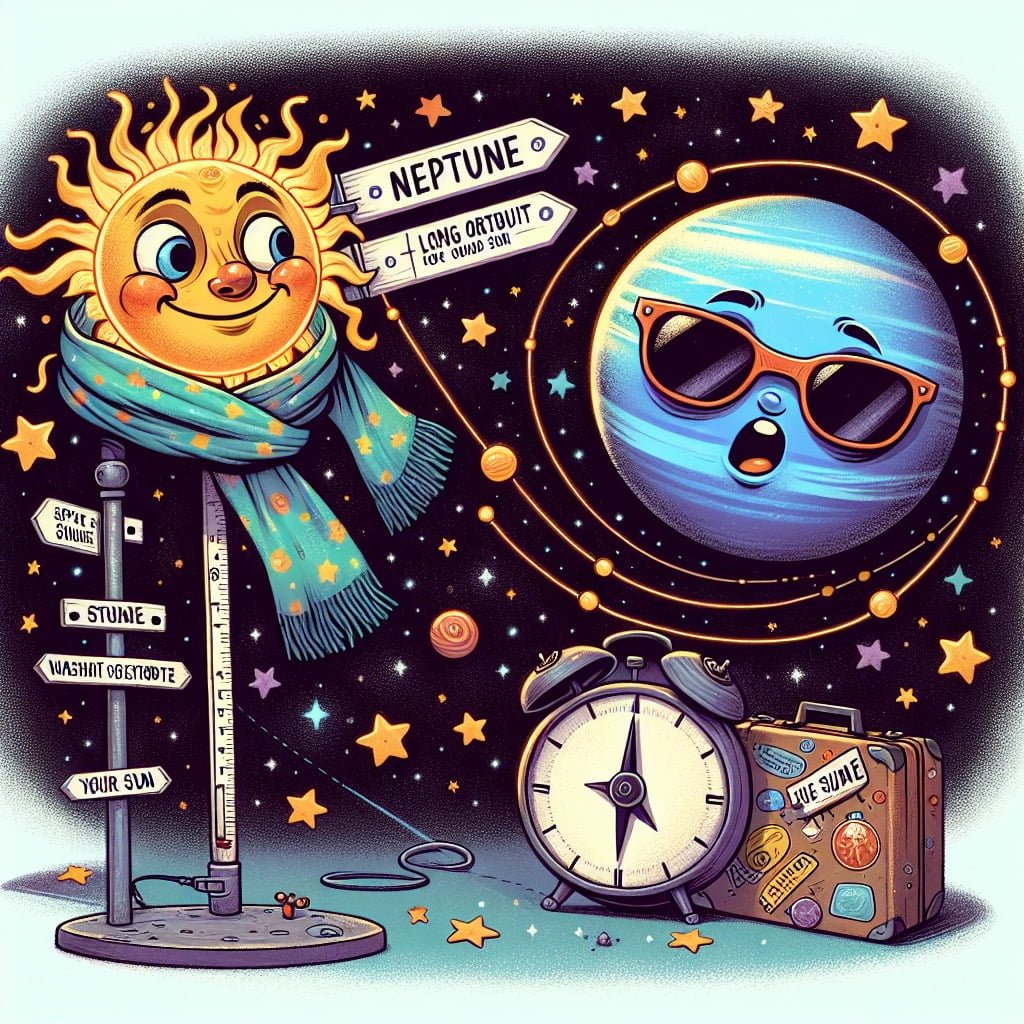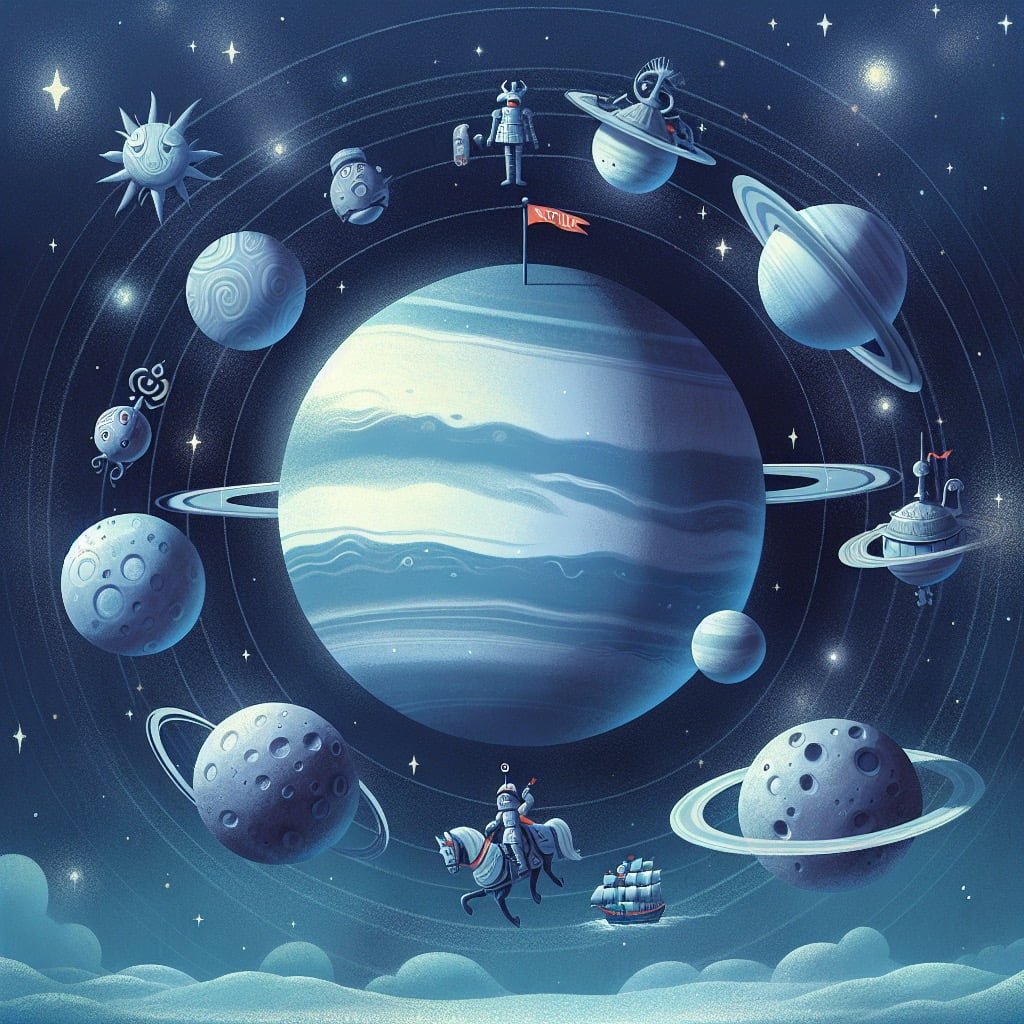Welcome to an enchanting exploration of fascinating Neptune facts for kids! In this captivating journey through the wonders of our solar system, we will uncover the unique characteristics and mysteries of Neptune, the eighth and farthest known planet from the sun. From the planet’s breathtaking blue color caused by methane gas to its powerful winds that make it the windiest in our solar system, Neptune is a celestial gem waiting to be discovered. Join us as we delve into fun and educational facts about Neptune, from its 14 enchanting moons to the intriguing concept of diamond rain on this distant planet. Let’s ignite the curiosity and imagination of young minds as we unravel the secrets of Neptune and the vast universe it resides in. Get ready for an adventure through the wonders of space with Neptune facts tailored especially for kids!
Neptune Facts For Kids
1. Neptune has the Strongest Winds in the Solar System

For younger kids: Neptune has the windiest weather—stronger than any storm on Earth!
For older kids: With wind speeds that can reach up to 1,600 miles per hour (2,575 kilometers per hour), Neptune has the fastest and most powerful winds in our entire solar system.
Detailed explanation:Neptune, the eighth and most distant planet in our solar system, is known for having the strongest winds in the entire solar system. These winds can reach incredibly high speeds, with gusts of up to 1,500 miles per hour. To put this into perspective, that’s about twice as fast as the most powerful hurricanes on Earth.
One of the reasons for Neptune’s extremely high wind speeds is its unique atmosphere. Neptune is primarily made up of hydrogen and helium, with traces of methane that give the planet its striking blue color. The planet’s atmosphere is incredibly dynamic, with massive storms and turbulent weather patterns constantly raging across its surface.
Another factor that contributes to Neptune’s strong winds is its distance from the Sun. Being the farthest planet from the Sun, Neptune receives very little sunlight and therefore has a much colder atmosphere compared to the inner planets like Earth. This temperature difference between the equator and poles creates intense temperature gradients, leading to powerful wind currents.
For kids who are interested in learning more about Neptune, it’s important to understand that despite its distant location and icy exterior, Neptune is a fascinating and dynamic planet with many unique features. Its extreme wind speeds are just one of the many intriguing Neptune Facts For Kids to explore and discover.
Neptune Facts For Kids
2. Neptune is the Farthest Planet from the Sun

For younger kids: Neptune is super far away from the sun, so it’s really cold there!
For older kids: Neptune is located about 2.8 billion miles (4.5 billion kilometers) away from the sun, making it the most distant planet in our solar system.
Detailed explanation:Neptune Facts For Kids reveal that Neptune is the eighth and farthest planet from the sun in our solar system. With an average distance of about 4.5 billion kilometers from the sun, Neptune is known for being the most distant planet in our solar system. This vast distance from the sun means that Neptune has a very long orbital period, taking about 165 Earth years to complete one orbit around the sun.
One interesting fact about Neptune is its blue color, which is caused by the presence of methane in its atmosphere. The methane absorbs red light, giving Neptune its distinctive blue hue. Another fascinating aspect of Neptune is its strong winds, which can reach speeds of up to 2,100 kilometers per hour, making them the fastest in the solar system.
Despite being far from the sun, Neptune experiences extreme temperatures due to its thick atmosphere and icy composition. The average temperature on Neptune is around -200 degrees Celsius, making it one of the coldest planets in our solar system. Neptune also has a series of dark, rotating storms, the most famous of which is the Great Dark Spot, reminiscent of Jupiter’s Great Red Spot.
In conclusion, Neptune’s distance from the sun, unique color, extreme temperatures, and powerful winds make it a fascinating planet to study. Its remote location in the outer solar system adds to its mysterious allure, making it a captivating subject for astronomers and space enthusiasts alike. Neptune Facts For Kids provide a deeper understanding of this distant and enigmatic planet.
Neptune Facts For Kids
3. A Year on Neptune is Almost 165 Earth Years

For younger kids: It takes a looong time for Neptune to go around the sun once!
For older kids: It takes about 165 Earth years for Neptune to complete a single orbit around the sun, which means that one year on Neptune is equivalent to 165 Earth years!
Detailed explanation:Neptune, the eighth and farthest known planet from the Sun in our solar system, is a fascinating and mysterious world. One of the most intriguing Neptune Facts For Kids is that a year on Neptune is almost 165 Earth years. This incredible length of time is due to Neptune’s immense distance from the Sun, which results in a much longer orbit around the star.
Neptune’s distance from the Sun is about 30 times that of Earth’s distance, which means that it takes almost 165 Earth years for Neptune to complete one orbit around the Sun. This slow progression through its orbit is further compounded by Neptune’s long days, which last for about 16 hours. This means that a year on Neptune is not only incredibly long, but also filled with long days and nights compared to those on Earth.
Neptune’s unique characteristics, such as its icy atmosphere, supersonic winds, and mysterious dark spots, make it a subject of study and fascination for scientists and astronomers. By studying Neptune and its long year, researchers can gain valuable insights into the outer reaches of our solar system and the processes that shape the planets within it.
Overall, the fact that a year on Neptune is almost 165 Earth years showcases the vast differences and complexities that exist within our solar system. It serves as a reminder of the incredible diversity and wonder of the planets that call the cosmos home.
Neptune Facts For Kids
4. Neptune has 14 Known Moons

For younger kids: Neptune has lots of moons that orbit around it like adventures in the sky!
For older kids: Currently, Neptune is known to have 14 moons, each with its own unique characteristics, contributing to the planet’s overall mysterious allure.
Detailed explanation:Neptune, the eighth and farthest planet from the Sun in our solar system, is a fascinating celestial body with many interesting features. One of the most intriguing aspects of Neptune is its impressive collection of moons. As of now, Neptune has a total of 14 known moons, each with its own unique characteristics and orbit around the planet.
These moons vary in size, shape, and composition, and each plays a crucial role in the dynamics of Neptune’s complex system. Triton, the largest moon of Neptune, is particularly noteworthy for its retrograde orbit, meaning it moves in the opposite direction of the planet’s rotation. This unusual feature suggests that Triton may have been captured by Neptune’s gravitational pull at some point in the past.
Other notable moons of Neptune include Proteus, Nereid, and Larissa, each offering valuable insights into the planet’s history and environment. These moons are believed to have formed from the debris left over from the formation of Neptune and its surrounding rings.
Studying the moons of Neptune can help scientists better understand the formation and evolution of the planet, as well as the broader processes that shape our solar system. By analyzing the composition, size, and behavior of these moons, researchers can gain valuable insights into the mysteries of Neptune and its place in the cosmos.
In conclusion, the 14 known moons of Neptune offer a wealth of information for researchers and space enthusiasts alike. By delving deeper into the Neptune Facts For Kids, we can unlock the secrets of this distant planet and expand our understanding of the universe.
Neptune Facts For Kids
5. The Color of Neptune is Caused by Methane Gas

For younger kids: Methane gas makes Neptune look blue like a big ocean in space!
For older kids: The distinct blue color of Neptune is a result of high levels of methane in its atmosphere, which absorbs red light and reflects blue light, creating its characteristic hue.
Detailed explanation:One of the fascinating Neptune Facts For Kids is that the color of the planet Neptune is actually caused by methane gas. Neptune is the eighth and farthest planet from the sun in our solar system, and its bluish hue sets it apart from the other gas giants.
The reason for Neptune’s distinct color can be attributed to the presence of methane gas in its atmosphere. Methane gas absorbs red light and reflects blue light, giving the planet its trademark blue appearance. The methane in Neptune’s atmosphere scatters the sunlight that hits it, creating the blue color that we see from Earth.
In addition to methane, Neptune’s atmosphere also contains traces of other gases such as hydrogen, helium, and ammonia. These gases contribute to the planet’s overall composition and appearance. The varying concentrations of these gases at different altitudes in Neptune’s atmosphere create the stunning cloud formations and weather patterns that we observe on the planet.
Studying the color of Neptune can provide scientists with valuable insights into the planet’s atmosphere and composition. By analyzing the light that is scattered and reflected by the methane gas in Neptune’s atmosphere, researchers can learn more about the planet’s weather patterns, climate, and overall makeup.
In conclusion, the blue color of Neptune is a result of the methane gas in its atmosphere. This fascinating aspect of the planet highlights the diverse and complex nature of our solar system’s outer planets, making Neptune a truly intriguing subject for further study and exploration.
Neptune Facts For Kids
6. Neptune was the First Planet Located Through Mathematical Predictions

For younger kids: Scientists used math to find Neptune before they even saw it in a telescope!
For older kids: Neptune’s existence was first predicted using mathematical calculations before it was actually observed through a telescope, showcasing the incredible power of scientific predictions.
Detailed explanation:One fascinating fact about Neptune is that it was actually the first planet to be discovered through mathematical predictions rather than direct observation. In the early 19th century, astronomers noticed irregularities in the orbit of Uranus that could not be explained by the gravitational pull of the known planets. This led French mathematician Urbain Le Verrier and British mathematician John Couch Adams to independently calculate the approximate location of an unknown planet that could be causing these discrepancies.
Using complex mathematical equations and Newton’s laws of gravitation, both Le Verrier and Adams predicted the existence and position of this mysterious planet beyond Uranus. In 1846, German astronomer Johann Gottfried Galle used these calculations to locate Neptune within one degree of its predicted position. This remarkable discovery confirmed the power of mathematical predictions in the field of astronomy.
Neptune Facts For Kids can be quite interesting as they learn about how this distant planet was not only discovered through mathematical calculations but also how its existence was inferred from the gravitational interactions with other planets. It serves as a reminder of the importance of mathematics in understanding the universe and how scientists can use this tool to uncover hidden secrets of the cosmos. Neptune’s discovery through mathematical predictions marked a significant milestone in the history of astronomy and continues to inspire scientists and children alike to explore the wonders of the solar system.
Neptune Facts For Kids
7. The Gravity on Neptune is Similar to Earth’s Moon

For younger kids: If you visited Neptune, you would feel like you’re jumping really high!
For older kids: The gravity on Neptune is approximately 17% stronger than Earth’s gravity, making it comparable to the gravitational pull experienced on our moon.
Detailed explanation:Neptune Facts For Kids can be a fascinating topic to explore, especially when considering the unique characteristics of this distant planet. One particularly interesting fact about Neptune is that its gravity is similar to that of Earth’s Moon. This may come as a surprise to many, as Neptune is a gas giant and much larger in size compared to the Moon.
The reason for this similarity in gravitational pull lies in the composition and mass of Neptune. While Neptune is indeed much larger than the Moon in terms of size, its density is actually lower. This means that the gravitational force on Neptune is not as strong as one might expect for a planet of its size. In fact, the surface gravity on Neptune is only about 17% stronger than that of the Moon.
For kids interested in space and astronomy, understanding this fact about Neptune can provide a sense of perspective on the different forces at play in our solar system. Exploring the reasons behind this similarity in gravity can also lead to discussions about density, mass, and the laws of physics that govern the universe. Overall, Neptune’s gravity being similar to that of Earth’s Moon is just one of the many intriguing Neptune Facts For Kids to spark curiosity and wonder about the mysteries of the cosmos.
Neptune Facts For Kids
8. Neptune’s Rings are Named After Famous Astronomers

For younger kids: Neptune has pretty rings, just like Saturn, and they’re named after special people!
For older kids: Neptune has five main rings, each named after a famous astronomer who made significant contributions to our understanding of the planet and the universe.
Detailed explanation:One fascinating fact about Neptune is that its rings are named after famous astronomers. These astronomers made significant contributions to the field of astronomy, and in recognition of their work, Neptune’s rings were named after them.
The five main rings of Neptune are named Galle, Le Verrier, Lassell, Arago, and Adams. These rings were discovered in the 1980s by the Voyager 2 spacecraft. The names of these rings pay tribute to astronomers who were influential in the discovery and understanding of Neptune.
For example, the Galle Ring is named after Johann Gottfried Galle, the German astronomer who, along with Urbain Le Verrier, discovered Neptune in 1846. The Le Verrier Ring is named after Urbain Le Verrier, the French mathematician who predicted the existence and location of Neptune based on mathematical calculations.
The Lassell Ring is named after William Lassell, the English astronomer who discovered Triton, Neptune’s largest moon. The Arago Ring is named after Francois Arago, the French astronomer who first suggested the existence of a planet beyond Uranus. Lastly, the Adams Ring is named after John Couch Adams, the English mathematician who also independently predicted the existence of Neptune.
Overall, the names of Neptune’s rings serve as a reminder of the important contributions made by these astronomers to the field of astronomy. By honoring their work in this way, Neptune’s rings help to educate and inspire future generations of astronomers and space enthusiasts. These Neptune Facts For Kids are a fun way to learn more about the history of astronomy and the exciting discoveries made in our solar system.
Neptune Facts For Kids
9. It Rains Diamonds on Neptune

For younger kids: It can rain diamonds on Neptune because it’s so amazing and magical!
For older kids: Scientists have theorized that the atmosphere of Neptune contains carbon, which could condense into diamond rain under the extreme pressure and temperatures on the planet.
Detailed explanation:Neptune Facts For Kids are not always widely known, but one fascinating fact about the distant planet is that it rains diamonds in its atmosphere. This may sound like something out of a science fiction movie, but it is a reality on Neptune. The conditions on Neptune are incredibly unique, with temperatures dropping as low as -214 degrees Celsius and incredibly high pressure in its atmosphere.
Scientists believe that the intense pressure in the atmosphere of Neptune causes methane gas to turn into carbon, which then hardens into diamonds as it falls towards the planet’s core. These diamonds are likely to be small and not the sparkling gems we are used to seeing, but the fact that diamonds are actually raining from the sky on Neptune is truly remarkable.
Studying Neptune and its diamond rain can provide valuable insights into the composition and behavior of the planet’s atmosphere. It also highlights the extreme and otherworldly conditions that exist on this distant planet. While Neptune may be over 4 billion kilometers away from Earth, learning about its unique features such as diamond rain can capture the imaginations of children and adults alike.
In conclusion, Neptune Facts For Kids can include the fascinating tidbit that diamonds are actually forming and falling from the sky on this distant planet. This fact showcases the incredible diversity and wonders that exist in our solar system, making Neptune a truly intriguing subject for exploration and study.
Neptune Facts For Kids
10. Neptune Has Not Completed a Full Orbit Since Its Discovery

For younger kids: Neptune hasn’t finished going around the sun even once since it was found!
For older kids: Since its discovery in 1846, Neptune has not completed a full orbit around the sun, marking a unique and remarkable aspect of its celestial journey.
Detailed explanation:Neptune, the eighth and farthest planet from the Sun in our solar system, has remained a source of fascination and mystery since its discovery in 1846. Despite being the fourth largest planet by diameter, Neptune is known for its slow orbital period, taking approximately 164.8 Earth years to complete just one orbit around the Sun. This means that since its discovery over 170 years ago, Neptune has not yet completed a full orbit.
One of the most interesting Neptune Facts For Kids is the planet’s unique blue color, which is caused by the presence of methane in its atmosphere. This methane absorbs red light, giving the planet its distinctive hue. Despite being so far from the Sun, Neptune experiences some of the strongest winds in the solar system, with gusts reaching speeds of up to 1,200 miles per hour. These winds are thought to be driven by the planet’s internal heat and its fast rotation.
Another intriguing aspect of Neptune is its system of rings and moons. The planet has a total of 14 known moons, the largest of which is Triton. Triton is unique in that it orbits Neptune in the opposite direction of the planet’s rotation, suggesting that it may have been captured from the Kuiper Belt, a region of icy bodies beyond Neptune. In addition to its moons, Neptune is also surrounded by a faint set of rings, although they are not as prominent as those of Saturn.
Overall, Neptune’s slow orbit, blue color, strong winds, and unique moons make it a fascinating subject of study for astronomers and space enthusiasts alike. The fact that Neptune has not yet completed a full orbit since its discovery only adds to its mystique and allure.
Did You Know?
Neptune’s blue color is so stunning because of the intense methane in its atmosphere, and it’s also the windiest planet in our solar system!
‘Summary of Neptune Facts For Kids’
Embark on a fascinating journey through the wonders of our solar system with a deep dive into Neptune, the mysterious eighth planet that continues to captivate the minds of astronomers and space enthusiasts alike. From its stunning blue hue and breathtaking rings to its extreme weather patterns and fastest winds in the solar system, Neptune is truly a celestial wonder waiting to be explored.
Discover fun and educational facts about Neptune, such as its 14 moons with Triton being the largest, and how its icy clouds and dark spots add to its enigmatic allure. By learning about Neptune, kids can expand their knowledge of astronomy and planetary science while also igniting a sense of wonder and curiosity about the vast universe we inhabit.
Unravel the secrets of Neptune and delve into the limitless possibilities that the cosmos holds. Whether you’re a budding space enthusiast or a curious mind eager to learn more about the wonders of outer space, exploring Neptune’s unique features and mysteries is sure to spark a sense of awe and appreciation for the beauty and complexity of our solar system. Join us on this thrilling adventure of discovery and exploration as we unveil the fascinating world of Neptune and the infinite universe it resides in.
Sources and additional information for Neptune Facts For Kids
WikipediaBritannicaNASAEuropean Space Agency (ESA)Space.comAstrophysical JournalSky & TelescopeUniverse TodaySpaceXThe Planetary SocietyAstronomy MagazineHubbleSiteNational Geographic KidsNASANational Air and Space MuseumESA KidsSpace.comThe Planetary SocietyNational Radio Astronomy Observatory (NRAO)Hayden PlanetariumSky & Telescope




